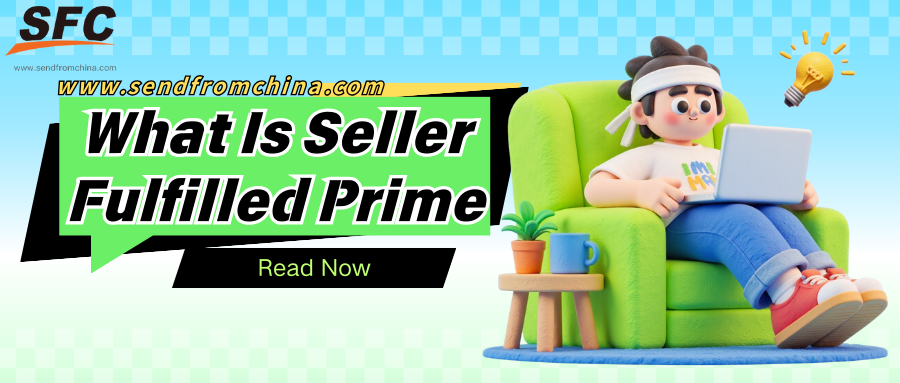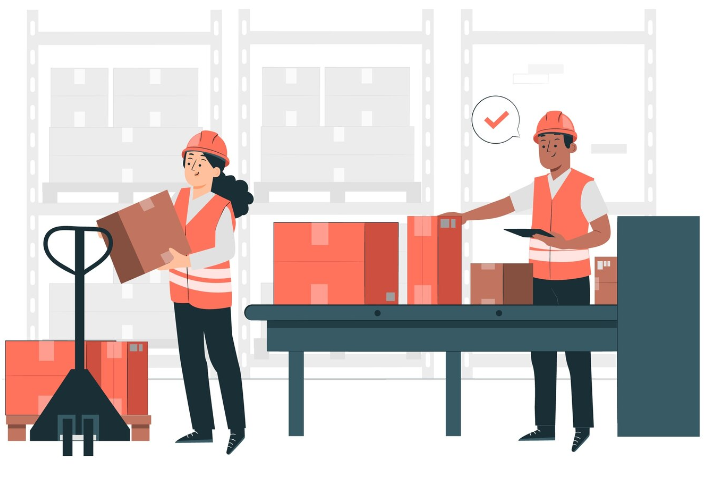Table of Contents
Get Custom eCommerce Fulfillment Service
Book a Meeting
What Is Seller Fulfilled Prime? A Comprehensive Guide with Pros, Cons & Comparison
Time: Aug 13,2025 Author: SFC Source: www.sendfromchina.com
Amazon’s Seller Fulfilled Prime program turns heads because it hands sellers the Prime badge without chaining them to Amazon’s warehouses. Think: the speed and prestige of Prime, but with the freedom to ship from your own facility or a trusted 3PL. Since its 2015 debut and refreshed relaunch in late 2023, SFP has grabbed attention as savvy sellers push back against FBA’s rising fees and inventory limits.For logistics-heavy businesses like SendFromChina, SFP represents more than a badge—it’s a chance to deliver faster, maintain brand control, and manage costs proactively. But it isn’t a stroll in the park. Amazon demands consistently fast delivery, near-perfect tracking, and razor-sharp operational precision just to get in the door.
This article will walk you through the essentials—from what Seller Fulfilled Prime is, to how it stacks up against FBA—and reveal whether SFP might be your ticket to carving out a unique space in the Prime ecosystem.

1. What Is Seller Fulfilled Prime
Seller Fulfilled Prime (SFP) is Amazon’s program that empowers sellers to handle Prime-eligible shipping from their own warehouse or via a trusted 3PL, while still displaying that coveted Prime badge. Essentially, you juggle fulfillment yourself—rather than using Amazon’s FBA service—yet you deliver the 1- to 2-day experience Prime customers expect.It means crossing a high bar: top-tier shipping performance, reliable tracking, and stellar customer service. But when done well, Prime listings can accelerate visibility and sales—without locking inventory into Amazon’s system.
2. Pros and Cons of Seller Fulfilled Prime
When you're evaluating SFP, you're weighing flexibility and brand control against operational rigor and expense. Here's a more fleshed-out breakdown, drawing from Amazon's latest requirements, industry data, and real seller voices to give your readers clarity—and confidence.Pros of Seller Fulfilled Prime

Prime Badge Drives Visibility & Sales
Securing that Prime badge can mean serious uplift. Sellers often see over 50% sales growth once they're Prime-eligible, thanks to enhanced visibility and trust among Prime shoppers.Avoid FBA Fees & Storage Hassles
SFP frees you from FBA’s long-term storage and inbound fulfillment fees—ideal if you already handle your own warehousing or have bulky, heavy inventory.Full Fulfillment Control & Branding
No more standardized Amazon packaging. With SFP, your brand shines through—custom packaging, notes, inserts, or handling for fragile items stay entirely in your hands.Leverage Amazon Customer Service
While you keep control over fulfillment, Amazon handles customer service. That 24/7 support frees you from fielding routine queries, keeping operations smoother.Better Returns Tracking & Handling
Unlike FBA, where returned items often arrive mixed or unscanned, SFP keeps returns in your system—helping identify issues and reducing losses from mismanaged returns.Ideal for Specialized or Multi-Channel Operations
If you sell quirky, seasonal, or oversized inventory, or if you operate across Shopify, eBay, and Amazon, SFP offers the flexibility and responsiveness that FBA often can’t.Cons of Seller Fulfilled Prime

High Shipping Costs Erode Margins
You’re responsible for the cost of expedited shipping that qualifies for Prime—shipping that can eat right into your margins, especially on low-priced items.A seller’s candid Reddit feedback drives the point home:
“Any delay by the carrier will be counted against you—even if it’s not your fault… SFP is feasible for high volume sellers with warehouses on each coast…”
Demanding Performance Metrics
Expect Amazon to judge you ruthlessly:- On-time shipping: ~99%
- Cancellation rate: ≤ 0.5%
- Tracking accuracy: ≥ 99%
Missing the mark means losing your Prime privileges fast.
Scaling Requires Logistics Sophistication
As sales climb, managing fast fulfillment from one warehouse becomes a liability. Investing in additional facilities or 3PL partnerships is a must—or risk disqualification.Strict Amazon Rules & Carrier Limitations
Amazon only approves certain carriers and labels, and changes can happen suddenly—some sellers find FedEx Ground disabled temporarily, forcing last-minute adjustments.Operational Burden & Infrastructure Costs
Running SFP demands warehouse staffing, tight cutoffs, packing systems, and a fulfillment rhythm that never falters. Without the right infrastructure, it can become overwhelming.3. How to Qualify for Seller Fulfilled Prime
Qualifying for Seller Fulfilled Prime isn’t a flip of a switch—it’s more like proving your logistics worthiness. You’ll need a blend of infrastructure, precision, and consistent performance. The path to SFP can be broken down into three core phases: pre-qualification, trial, and ongoing maintenance.
Pre-Qualification: Setting the Stage
First off, make sure you have the fundamentals:- A Professional Seller Account: Sellers need an Amazon Professional account in good standing to even attempt SFP.
- A Domestic Fulfillment Address: Your default shipping address must be within the US (or the program-specific region).
Then, look at your metrics over the last 90 days:
| Metric | Threshold |
|---|---|
| Self-fulfilled packages | ≥ 100 |
| Cancellation rate | ≤ 2.5% |
| Valid tracking rate | ≥ 90–95% |
| Late shipment rate | ≤ 4% |
The combination shows Amazon you're structured and consistent enough to move forward.
The Trial Period: Prove You Can Deliver
Once pre-qualified, the trial begins. Amazon typically grants a 30-day window, during which you must fulfill at least 100 Prime trial orders. Metrics tighten, and speed is everything:On-Time Delivery: ≥ 93.5%
Valid Tracking Rate: ≥ 99%
Seller Cancellation Rate: ≤ 0.5%
Delivery Speed Requirements: These vary based on item size. For example (as of Sept 2024):
- Standard-size: ≥30% one-day, ≥70% two-day
- Oversize: ≥10% one-day, ≥45% two-day
- Extra Large: ≥15%
You'll need zero-day handling—meaning same-day shipping cutoffs. And make sure the SKUs you select are correctly mapped to the Prime shipping templates, or your performance won't be properly tracked.
During this period, the Prime badge is withheld, but passing unlocks it for qualified listings.
Ongoing Eligibility: Sustain the Prime Promise
Passing the trial is just the start. To continue as an SFP seller, you must uphold performance and coverage standards:- Maintain on-time delivery (≥ 93.5%), valid tracking (≥ 99%), and cancellation (≤ 0.5%)
- Weekend fulfillment: Ship orders Saturday—or at least one weekend day—to meet Amazon’s six-day expectation
- Offer nationwide delivery across the contiguous U.S.
- Provide free returns for items under 50 pounds
- Use Amazon-approved carriers and standard Prime shipping templates
- Let Amazon manage customer service and returns—reflecting their commitment to Prime customer experience
You must continue to meet these thresholds every week. Slip on one, and you could lose Prime privilege quickly.
Real Sellers from the Field
A few candid reflections from sellers:“Any delay by the carrier—even if out of your hands—won’t go unnoticed. SFP only works if you have dense regional logistics.”
—SFP seller, Reddit
Another seller highlights the tension between independence and Amazon's strict control:
“It’s nearly impossible to maintain SFP at scale unless you have warehouses across time zones and high margins.”
4. How Does Seller Fulfilled Prime Work?
Seller Fulfilled Prime allows sellers to offer that coveted Prime badge—without Amazon handling the hands-on fulfillment. You still manage storage, packing, and shipping—but Amazon signals that you're meeting Prime-level standards. Here’s how the process unfolds in a structured, step-by-step flow:
Step 1: Pre-Qualification & Trial Trigger
It all starts in Seller Central. You must first confirm you're eligible for the Prime trial by meeting performance requirements—like having a U.S. shipping address, a Professional Seller account, and strong metrics for delivery, tracking, and cancellations. Once approved, you officially register for the 30-day SFP trial.During this period, you'll need to ship at least 100 Prime trial orders that meet Amazon’s high standards for delivery speed and accuracy. It’s your moment to prove reliability.
Step 2: Enabling Prime Shipping & SKU Mapping
You’ll configure a Prime shipping template—defining 1-day and 2-day shipping zones—and assign qualifying SKUs to it. Orders with that template are tagged as Prime trial orders. That way, Amazon can monitor your performance during the trial precisely.Step 3: Packing, Shipping & Tracking
Once a trial order lands, you must act fast—same-day processing and shipping is a must. Use Amazon Buy Shipping or approved carriers to purchase labels and generate accurate tracking, ideally automatically.You’ll need to track the shipments to ensure delivery meets the promised speed (often two-day delivery) and that tracking data remains accurate and accessible.
Step 4: Amazon Handles Post-Order Support
Here’s the relief: once the order is placed, Amazon takes care of customer service, returns, and refunds for Prime orders. You fulfill the delivery, while Amazon manages the post-purchase touchpoints under Prime’s high-standard service umbrella.Step 5: Evaluation & Prime Badge Assignment
Meet (and maintain) performance thresholds—on-time delivery ≥ 93.5%, valid tracking ≥ 99%, cancellation ≤ 0.5%—and Amazon will grant your listings the Prime badge after the trial.From then on, the program enters “maintenance mode,” where your performance is evaluated weekly. Miss the metrics, and your Prime status could be wrenched away.
Step 6: Volume Control & Ongoing Monitoring
Once fully approved, you're expected to support consistent, nationwide Prime delivery—yes, even on weekends. You’re given tools like the Control Prime order volume, which lets you cap how many 1- or 2-day orders you can take, based on your capacity.Your Seller Fulfilled Prime Performance Dashboard will be your dashboard for real-time insights and alerts.
5. FBA vs. SFP: How to Choose
When deciding between Fulfillment by Amazon (FBA) and Seller Fulfilled Prime (SFP), it's crucial to align your choice with your business model, operational capacity, and financial goals. Both fulfillment methods offer unique advantages and challenges, and the best option depends on your specific circumstances.
Fulfillment by Amazon (FBA): The Hands-Off Solution
FBA involves sending your inventory to Amazon's fulfillment centers, where Amazon handles storage, packing, shipping, and customer service.Best For: Sellers with a broad product range, limited fulfillment resources, or those looking to expand rapidly without significant upfront investment.
Seller Fulfilled Prime (SFP): The Control-Focused Option
SFP allows sellers to fulfill Prime orders from their own facilities, maintaining control over inventory and shipping while still offering Prime benefits.Best For: Established sellers with reliable fulfillment operations seeking greater control and potentially lower costs.
Comparative Overview
| Feature | FBA | SFP |
|---|---|---|
| Prime Eligibility | Automatic | With Requirements |
| Fulfillment Control | Limited | Full |
| Fees | Higher (storage, fulfillment) | Lower (shipping, handling) |
| Customer Service | Amazon Handles | Seller Handles |
| Scalability | High | Moderate |
| Infrastructure | Amazon's Facilities | Seller's Facilities |
Decision-Making Considerations
When choosing between FBA and SFP, consider the following factors:- Product Type: Large, heavy, or customizable items may benefit from SFP due to lower shipping costs.
- Operational Capacity: Assess your ability to meet Amazon's performance metrics and manage fulfillment processes.
- Cost Structure: Compare the total cost of each option, including all associated fees and expenses.
- Customer Experience: Consider how each fulfillment method aligns with your brand's customer service standards.
6. Seller Fulfilled Prime Costs in 2025
Seller Fulfilled Prime offers sellers the opportunity to display the coveted Prime badge on their listings without utilizing Amazon's Fulfillment by Amazon services. However, this program comes with its own set of costs that sellers must consider to determine profitability.
Program Fee
For each item sold through the SFP program, Amazon charges a program fee of 2% of the total item price, with a minimum fee of $0.25 per unit. This fee applies to items sold to Prime customers via an offer associated with a Prime shipping template. It's important to note that this fee is in addition to other selling fees and fulfillment costs.Shipping Costs
Sellers participating in SFP are responsible for shipping all Prime orders, including offering free standard shipping, which can increase costs depending on package size, shipping method, and destination. Sellers have the flexibility to choose their carriers, but they must ensure that they meet Amazon's delivery speed requirements to maintain their Prime eligibility.Selling Plan Cost
To enroll in the SFP program, sellers must be on Amazon's Professional Selling Plan, which costs $39.99 per month. This plan provides access to advanced selling tools and features, making it suitable for high-volume sellers.Referral Fees
Sellers are required to pay referral fees on every sale. These fees typically range from 5% to 45% of the product price, depending on the product category. For most categories, the average referral fee is around 15%. It's essential for sellers to factor in these fees when calculating their profit margins.Additional Considerations
- Performance Metrics: To maintain Prime eligibility, sellers must consistently meet Amazon's performance metrics, including on-time delivery and valid tracking. Failure to meet these standards can result in the loss of Prime status.- Infrastructure Costs: Sellers need to invest in robust logistics and warehousing capabilities to handle the fulfillment of Prime orders. It includes costs associated with inventory management, packaging, and shipping.
- Carrier Selection: While Amazon allows sellers to choose their carriers, it's crucial to select those that offer reliable and cost-effective services to ensure timely deliveries and maintain Prime eligibility.
7. SFP’s Kill Switches: 3 Metrics That Get Sellers Banned
Think of these as “kill switches.” If they trip, you risk losing Prime status—or worse.- On-Time Delivery Rate: Fall below Amazon’s threshold (often 93.5–99% depending on report), and your badge disappears—and orders dwindle.
- Valid Tracking Rate: Under 99%? Amazon suspends SFP eligibility immediately. No tracking, no trust.
- Order Cancellation Rate: If it exceeds 0.5%, you’re out. Too many cancellations signal unreliability.
Other factors like poor customer feedback or slow refunds can trigger removal. One seller grumbled about skewed metrics during holidays—and Amazon responded—but there’s little margin for error.
8. Conclusion
SFP is a powerful tool—combining Prime’s prestige with seller control. But it’s not for every operation. You need seamless logistics, fantastic metrics, and infrastructure to support fast shipping and efficient returns.For SendFromChina, SFP can offer differentiation—especially for oversized, seasonally-driven, or multi-channel products. With your expertise in cross-border logistics, guiding clients through SFP could become a compelling service offering.
In short: SFP = high reward, high demand. If performance is your strength, it's worth mastering.
9. FAQs
1. What is Seller Fulfilled Prime?
A program letting sellers fulfill Prime orders themselves (or through a 3PL) while displaying the Prime badge.2. How do I qualify?
Enroll in a trial, meet strict delivery, tracking, and cancellation metrics, and use Amazon-approved shipping.3. Is there an enrollment fee?
No, but you must have the Professional Seller plan (~$39.99/month) and cover your own shipping and referral fees.4. What metrics can remove my Prime badge?
Low on-time delivery, poor tracking rate (<99%), and high cancellation rate (>0.5%) can get you removed from SFP.5. Should my business use SFP or FBA?
Use SFP if you control logistics well and want cost flexibility and brand control. Stick with FBA if you prioritize convenience and reliability over cost. Post Views:2047
Post Views:2047
Copyright statement: The copyright of this article belongs to the original author. Please indicate the source for reprinting.
Previous Post
Shopify Warehouse Management System: The Complete Guide
Next Post
TAGS
Hot Research
Get Custom eCommerce Fulfillment Service
Book a Meeting
Get a Custom China Fulfillment Solution with FREE Storage for 30 Days
 Want to know about our services, fees or receive a custom quote?
Want to know about our services, fees or receive a custom quote?
 Please fill out the form on the right and we will get back to you within a business day.
Please fill out the form on the right and we will get back to you within a business day.
 The more information you provide, the better our initial response
will be.
The more information you provide, the better our initial response
will be.





 TAGS:
TAGS: